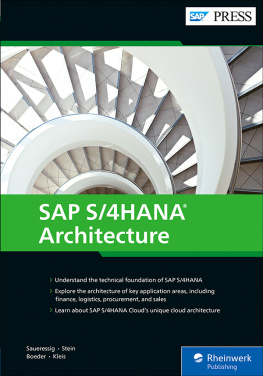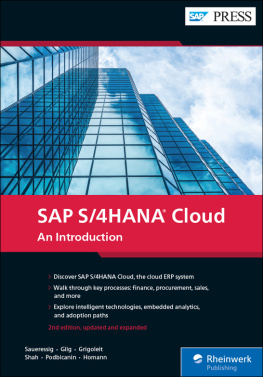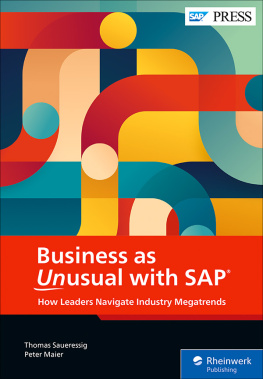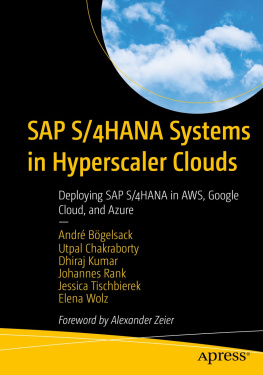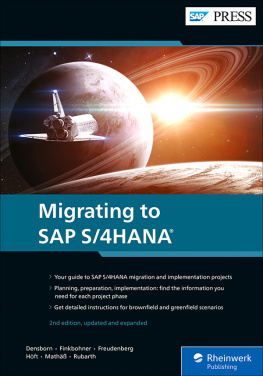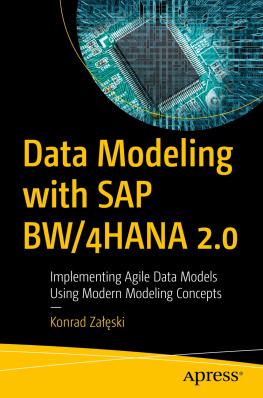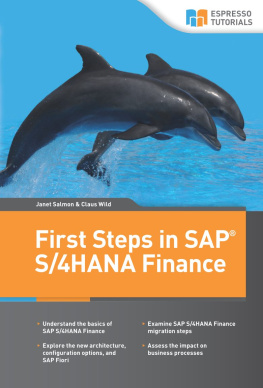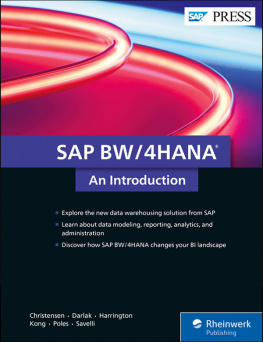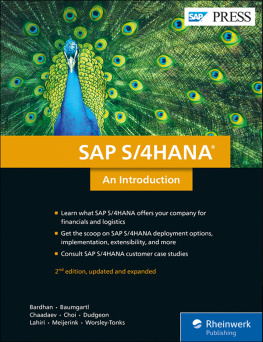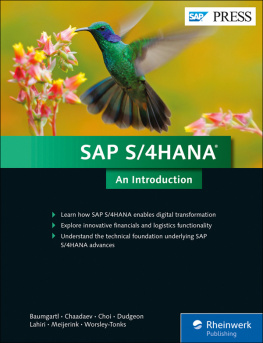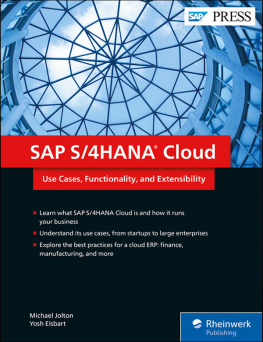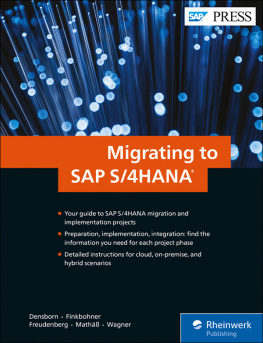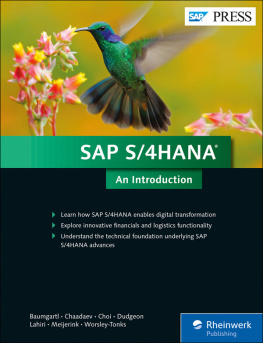Thomas Saueressig - SAP S/4HANA Architecture
Here you can read online Thomas Saueressig - SAP S/4HANA Architecture full text of the book (entire story) in english for free. Download pdf and epub, get meaning, cover and reviews about this ebook. year: 2021, publisher: Rheinwerk Publishing, genre: Home and family. Description of the work, (preface) as well as reviews are available. Best literature library LitArk.com created for fans of good reading and offers a wide selection of genres:
Romance novel
Science fiction
Adventure
Detective
Science
History
Home and family
Prose
Art
Politics
Computer
Non-fiction
Religion
Business
Children
Humor
Choose a favorite category and find really read worthwhile books. Enjoy immersion in the world of imagination, feel the emotions of the characters or learn something new for yourself, make an fascinating discovery.
- Book:SAP S/4HANA Architecture
- Author:
- Publisher:Rheinwerk Publishing
- Genre:
- Year:2021
- Rating:3 / 5
- Favourites:Add to favourites
- Your mark:
- 60
- 1
- 2
- 3
- 4
- 5
SAP S/4HANA Architecture: summary, description and annotation
We offer to read an annotation, description, summary or preface (depends on what the author of the book "SAP S/4HANA Architecture" wrote himself). If you haven't found the necessary information about the book — write in the comments, we will try to find it.
SAP S/4HANA Architecture — read online for free the complete book (whole text) full work
Below is the text of the book, divided by pages. System saving the place of the last page read, allows you to conveniently read the book "SAP S/4HANA Architecture" online for free, without having to search again every time where you left off. Put a bookmark, and you can go to the page where you finished reading at any time.
Font size:
Interval:
Bookmark:
Thomas Saueressig, Tobias Stein, Jochen Boeder, Wolfram Kleis

This e-book is a publication many contributed to, specifically:
Editor Will Jobst
Copyeditor Melinda Rankin
Cover Design Graham Geary
iStockphoto.com: 97970762/ Martin Barraud
Production E-Book Hannah Lane
Typesetting E-Book Satz-Pro (Germany)
We hope that you liked this e-book. Please share your feedback with us and read the to find out how to contact us.
The Library of Congress has cataloged the printed edition as follows: 2020946677
ISBN 978-1-4932-2023-6 (print)
ISBN 978-1-4932-2024-3 (e-book)
ISBN 978-1-4932-2025-0 (print and e-book)
2021 by Rheinwerk Publishing Inc., Boston (MA)
1st edition 2021
Its wise to start with the foundation.
For a consultant curious about SAP S/4HANA, its the architectural underpinnings of SAP S/4HANA. For us, the publisher, its a table of contents.
It all begins with a book concept: what is this book about, and whos the audience? For SAP S/4HANA Architecture, the topic is self-explanatory: the go-to guide for those interested in understanding the architecture of SAP S/4HANA. For audience, were aiming for technical and foundational consultants, architects, administrators, programmers, IT managers, and more. Then, the acquisitions editor develops a table of contentsa structure that defines the bookwith the authors and takes it to the SAP PRESS Editorial Board for approval.
Once weve laid our foundation, its time to build up. For you, thats working through each piece of core application architecture, developing a holistic understanding of SAP S/4HANA architecture. In other words, getting to know the whole by analyzing its parts. For SAP PRESS, thats the authors and editors working together to create a great manuscript, based on the building blocks defined in the table of contents.
What did you think about SAP S/4HANA Architecture ? Your comments and suggestions are the most useful tools to help us make our books the best they can be. Please feel free to contact me and share any praise or criticism you may have.
Thank you for purchasing a book from SAP PRESS!
Will Jobst
Editor, SAP PRESS
www.sap-press.com
Rheinwerk Publishing Boston, MA
This e-book is protected by copyright . By purchasing this e-book, you have agreed to accept and adhere to the copyrights. You are entitled to use this e-book for personal purposes. You may print and copy it, too, but also only for personal use. Sharing an electronic or printed copy with others, however, is not permitted, neither as a whole nor in parts. Of course, making them available on the Internet or in a company network is illegal as well.
For detailed and legally binding usage conditions, please refer to the section .
This e-book copy contains a digital watermark , a signature that indicates which person may use this copy:
You are reading this e-book in a file format (EPUB or Mobi) that makes the book content adaptable to the display options of your reading device and to your personal needs. Thats a great thing; but unfortunately not every device displays the content in the same way and the rendering of features such as pictures and tables or hyphenation can lead to difficulties. This e-book was optimized for the presentation on as many common reading devices as possible.
If you want to zoom in on a figure (especially in iBooks on the iPad), tap the respective figure once. By tapping once again, you return to the previous screen. You can find more recommendations on the customization of the screen layout on the .
Dear Reader,
By using business software applications, organizations around the globe can plan, control, and steer their cash resources, production capacities, and material supply, as well as track their sales and purchase processes. The enterprise resource planning (ERP) story is a success story for businesses. SAP is both a pioneer and a leader in providing enterprises with real-time transparency into their business processes.
Since the birth of business software applications, we have moved from the mainframe to client-server, mobile, and in-memory computing. The technology leap of the past few years has been leading businesses into the cloud, and SAP has been a trusted partner to its customers in delivering software that has always supported all the technology shifts of the past. With nearly 50 years of experience, we have gained deep insights into how businesses run. Together with our customers, we have defined best practices that have become standard procedures designed to help our customers succeed in the future. To date, SAP has more than 440,000 customers and 21,000 partners worldwide, and, according to a 2018 Oxford Economics SAP analysis, 77% of the worlds transaction revenue touches an SAP software system. This means that the global and hyperconnected economy relies on ERP applications from SAP and their foundation: a stable technological architecture that still allows for business flexibility.
Technological evolution goes hand in hand with business transformation. With new technology, business models are changing at an ever-increasing pace, and business processes must be designed accordingly, which makes agility key for companies. At the same time, customer expectations are changing too, and we see an increasing demand for hyperpersonalized, intelligent products manufactured in a fair and sustainable way. This requires an ERP architecture to enable built-in agility, allowing companies to adapt to rapidly changing technological and market opportunities.
However, reality shows us that many companies have large and highly customized ERP systems today covering very complex business processes that have evolved over the past few decades. That is why we often see scattered IT landscapes that cannot be moved easily to the cloud. Adding to the complexity is the challenge of delivering an integrated experience across ERP systems and line-of-business solutions through consistent data models and a seamless user experience. This reality demands a new architecture for modern ERP systems, and it requires companies to take a big step toward modernizing both their IT landscapes and the way they run their businesses to keep pace with the changing customer requirements and market conditions around them. It also requires a modern ERP system to be fully integrated.
Today, we have taken the best practices from the existing ERP architecture to provide companies with future-proof solutions. SAP S/4HANA is our next-generation, intelligent ERP system, using real-time data with SAP HANA, embedded analytics, and machine learning scenarios. It embraces artificial intelligence (AI) since the future of ERP is AI driven. It is leaner, faster, and more agile, helping enterprises predict and adapt to business disruptions and market changes. As a modern ERP system, SAP S/4HANA supports companies in scaling their businesses with the agility needed to remain resilient and competitive and to deliver the ultimate customer experience.
From a business process perspective, customers in todays hyperconnected business world are looking for solutions that cover end-to-end business processes, rather than specific capabilities within a solution. SAP solutions bring finance, procurement, engineering, manufacturing, logistics, sales, and services together in an orchestrated way from the edge to the core, and from the shop floor to the top floor. Our vision for SAP S/4HANA is to provide a business-process-as-a-service ERP system with out-of-the-box integration to other cloud-native SAP solutions and open interfaces to third-party products.
Font size:
Interval:
Bookmark:
Similar books «SAP S/4HANA Architecture»
Look at similar books to SAP S/4HANA Architecture. We have selected literature similar in name and meaning in the hope of providing readers with more options to find new, interesting, not yet read works.
Discussion, reviews of the book SAP S/4HANA Architecture and just readers' own opinions. Leave your comments, write what you think about the work, its meaning or the main characters. Specify what exactly you liked and what you didn't like, and why you think so.

